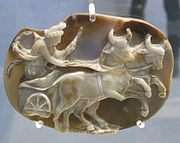Luna

Luna is the moon goddess in Roman mythology ; it corresponds to the Greek goddess of the moon Selene ("the shining, radiant one").
In Romance languages , her name has been retained as a name for the earth's moon , which is grammatically feminine here . The designation Luna or Frau Luna is also used in the German language, especially in translations to avoid problems with changing sex to “the moon”.
The Roman day of the moon goddess lunae dies ( Italian lunedí , French lundi ) was adopted in German as Monday (moon day). Common surnames for Luna in poetic literature are Trivia, Phoebe, Lucina, Dictynna and Cynthia .
mythology
Already in Greek mythology , the moon goddess has two siblings who were adopted by the Romans with Latin names: Luna's brother is the sun god Sol ( Greek Helios ), her sister is the dawn Aurora (Greek Eos ). Her parents are the titans Theia and Hyperion .
Ancient cult
There is little to suggest that the moon cult was an originally Italian custom. The most likely explanation lies in an initially Latin cult that was influenced by the cult of the Greek goddess Artemis or Selene . It was against this background that the depictions of Luna as a young woman on a chariot ( biga in Latin ) were probably created . Luna's brother, the sun god Sol, is also driving a chariot across the sky.
Like Sol, Luna was a patron deity of the Roman circus . Both together, he ascending and she descending, served as a pictorial representation of eternity.
In ancient Rome, the temple of Luna on the Aventine Hill was dedicated to her, where she was worshiped as the goddess of the month on the last day of March until 153 BC. The first month in the ancient Roman year . According to legend, this temple was founded by Servius Tullius . It stood near the Diana and Ceres sanctuaries and burned in 64 BC. BC. As Luna Noctiluca (about "candlestick of the night"), a temple was dedicated to her on the Palatine Hill , which was lit at night and was probably destroyed in the same year.
In the Roman Republic , the Luna cult seems to have been of little importance, as few reports about miraculous signs ( prodigies ) refer to Luna. In popular belief, however, their cult seems to have had a certain significance, as the reactions of ordinary people to a lunar eclipse show.
In the Roman Empire , Luna was mainly represented as a counterpart to Sol, the respective ruler was represented as the sun and his wife as the moon, and this divine order was transferred to political conditions.
literature
- Emil Aust: Luna . In: Wilhelm Heinrich Roscher (Hrsg.): Detailed lexicon of Greek and Roman mythology . Volume 2.2, Leipzig 1897, Col. 2154-2160 ( digitized version ).
- Georg Wissowa : Luna 2). In: Paulys Realencyclopadie der classischen Antiquity Science (RE). Volume XIII, 2, Stuttgart 1927, Sp. 1808-1811.
- Karl Kerényi : The Mythology of the Greeks. Volume 1: The stories of gods and mankind. dtv, Munich 2010, ISBN 978-3-423-30030-8 , p. 157.
- Françoise Gury: Selene / Luna . In: Lexicon Iconographicum Mythologiae Classicae (LIMC). Volume VII, Zurich / Munich 1994, pp. 706-715.
- Richard L. Gordon: Luna 1). In: The New Pauly (DNP). Volume 7, Metzler, Stuttgart 1999, ISBN 3-476-01477-0 , Sp. 505-508.
Web links
- Peter Lichtenberg: Luna. In: imperium-romanum.com. March 13, 2011, accessed October 29, 2013 .
Individual evidence
- ↑ Titus Livius : 44, 37, 5-9; and Pliny the Elder : Naturalis Historia. 28, 77.

